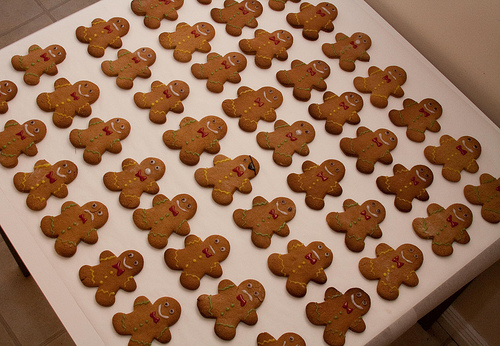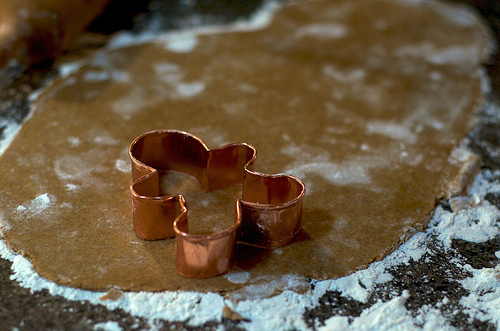Gingerbread men make me smile. I think they add a touch of whimsy to ordinary life.
They never say a word, yet they tickle my funny bone. In fact, I collect them. The little fellows grace my laundry room walls and they come in various sizes. And…yes. I have borders to match. (If I must wash and iron, I think my little niche should convey delight. I know. Somehow, that just doesn’t seem right, does it? )
But I digress.
If you’ve ever made gingerbread men you’ve probably used the standard gingerbread cookie cutter. Cookie cutter sizes may vary, but generally, they’re all about the same shape: a head, two arms, two legs, etc. And they’re usually standing upright.
When cookies (or in my example, gingerbread men) are created, initially, they all look the same. To add “character,” eye appeal, and of course, deliciousness, some craftsmanship is involved.
It takes time to gather the ingredients, stir, mix, roll out, bake, cool, and decorate. Dimension and depth are added to my make-believe friends by getting the recipe just right. Not only should the gingerbread men capture my attention (by the cuteness factor), but they certainly better taste good, too!
It’s the same with fiction. Whether we’re writing it or reading it, cookie-cutter characters leave us bored.
Frustrated.
Unmoved.
We want to write/read about characters who are different.
Interesting.
Unique.
We want to see how the characters are “decorated.”
Choice of clothing showcases characters’ fashion sense.
Facial expressions and body language reveal inner turmoil.
Feelings give us a glimpse into motivation.
In other words, our characters are brought to life by individual traits, mannerisms, and genetic make-up uniquely their own.
I once read a book in which every character seemed the same–just with a different name. (That’s not good either. As writers and readers we should immediately spot why this is wrong.)
The characters seemed lackluster. Everyone wore the same color. Everyone “rolled their eyes.” Most of the characters liked the same dessert, and I’m certain everyone owned a dog for a pet.
Somewhere in the first chapter, I wanted to shout, “Mauve! Please let ‘Sally Sue’ wear mauve and ‘Barbara Jean’ choose saffron. And enough with the eye rolling already. I’m getting dizzy.”
And why not have some of the characters try “Baked Alaska” instead of having the entire town be partial to strawberry shortcake?
And I also love dogs, but throw in a lizard, a turtle, or a chimpanzee for a little something off-beat.
While I love my “cookie-cutter” gingerbread folks, what “brings them to life” isn’t that they’re all the same. It’s the understated awareness that they’re all different.
In an inanimate, yet alive, kinda way.
*****
What tips can you share to avoid the cookie-cutter calamity?
Photo Credit: Erin_M/Creative Commons
**October’s blog drawing winner is Melissa T. Congratulations, Melissa! Please contact me with your mailing address so I can get your Target gift card in the mail.**
Happy Friday and Blessings Always,




Comments 3
I love Gingerbread. I love the Gingerbread man story. 🙂 Bailey made me an adorable ceramic ornament for Christmas when she was five that I still hang on the tree.
I read a book not long ago where every character but two (including waiters, pedestrians etc) had blue eyes and it was mentioned. I was like, “Does anyone NOT have blue eyes and why do we have to know everyone’s eye color anyway?”
I think we can describe characters in ways that will make them unique and give the reader a more colorful idea of who they are without ever telling actual colors. In fact, if it isn’t relevant, I don’t even comment on it. Leave it up to the reader. 🙂
Author
Jess, exactly! I think readers like picturing things in their own minds from the subtle details we drop in our stories. I believe it’s part of the creative process. And just like no two people are the same, neither should our characters be. I just finished reading a book where the character description was limited, yet, I didn’t get the feeling the characters were shallow, lifeless beings either. Because the story was so well-crafted, the characters seemed to burst forth on the page. Brilliant.
Great post and good point there, Jessica. In the book I’m working on now, quite a few people happen to have brown eyes. I ALWAYS seem to have to elaborate on eye-color! I don’t know why…anyway, will try to restrain myself more!